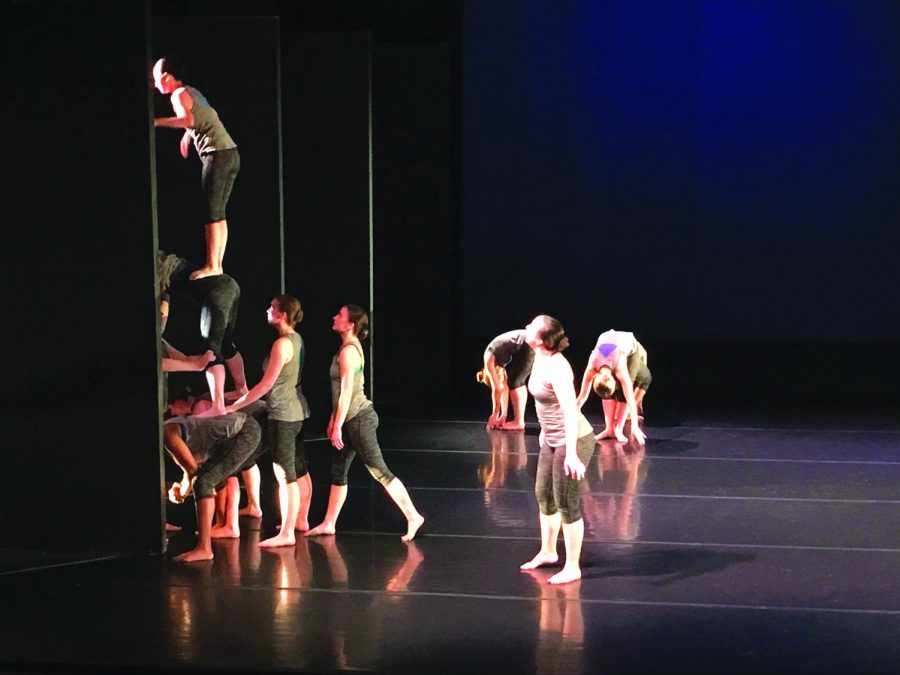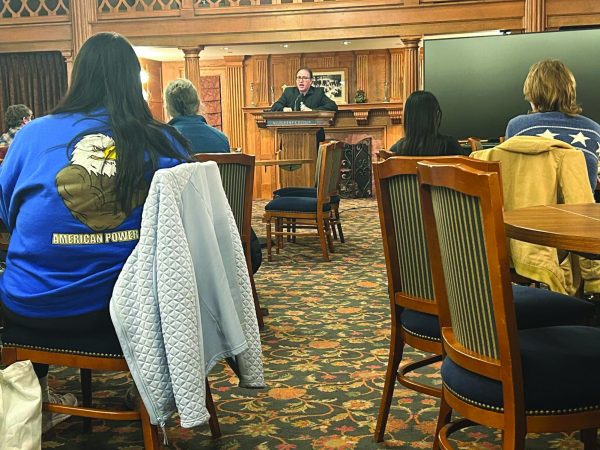Students perform in annual spring concert
Dance and movement studies showcase talent
Contemporary Dance students perform the dance “Changing Times.” The dance was directed by Eleanor Weisman and performed in the concert on Friday, April 6, 2018.
Over the course of the spring semester, the Dance and Movement Studies program has been preparing for one of its main events, the Spring Dance Concert. The annual concert was held on Thursday, April 5 and ran until Saturday, April 7 in the Montgomery Performance Space. It featured group performances from spring semester dance and movement classes as well as solos performed by Allegheny dance students.
“The spring dance concert is an opportunity for DMS to demonstrate the artistic value of dance and the expressive elements of movement in a venue that is not entertainment focused,” said Eleanor Weisman, department chair and associate professor of dance and movement studies.
A majority of the dance pieces performed in the concert were pieces the students learned in their dance classes. One class, Ballroom three, is strictly a performance class, which has the students learn the choreography of a specific piece throughout the semester that is performed in the spring concert. Most of the students have been practicing and rehearsing since the beginning of the semester for the concert.
“I was in [Betsy Sumerfield’s] piece and she had us have ten practices and they were two hours and 15 minutes each, which averaged out to 22 hours. But for another piece I was in it for a class,” Michaela Schlichtkrull, ’19, said.
With these performances, Weisman and the other faculty members involved were able to help students understand the importance of group effort.
“Our program’s approach is dance not only as self-expression but also as group process. You would see that in the [four] larger group pieces … Being a supportive member of the group is as important as one’s own technical movement prowess,” Weisman said.
Weisman stressed this idea of synergy involved in group dances, specifically the four group pieces which were performed at the concert.
“We want to encourage our students to build on their ability and their capabilities as movers and dancers but we also want them to see themselves as part of a community and as a group effort,” Weisman said.
The first group piece, called “Changing Times” was 15 minutes long and choreographed by Weisman. The piece was performed by her History of Contemporary Dance students, who studied the dances of dance pioneers of the twentieth century used in the piece, such as Merce Cunningham.
“We explored movement that reflected the historical time period and the historical dance figure, and then we figured out how to make it all fit together into a piece,” Weisman said.
Professor Douglas Jurs, assistant professor of music, was part of “Changing Times” in which he performed the piano throughout the piece. Jurs had come to Weisman three years ago to ask about doing a collaboration with Jurs playing sonatas and interludes by John Cage in a dance piece.
To create the same tone as Cage and his 1940s piano, Jurs had to deconstruct certain parts of the piano. The piano was taken apart in a specific way to create the dissonant tone needed to play the piece and create a similar artistic expression that Cage had developed. It took Jurs three hours to prepare the piano for the performance according to Weisman.
The second group dance was “A Balanchine Salute,” which was staged by Gretchen Myers, part-time instructor of the dance and movement studies. The ballet class taught by Myers performed the dance piece, which was choreographed by George Balanchine, who is also taught in the history of contemporary dance by Weisman. The piece is one of the 1970s modern ballet pieces by Balanchine which incorporated elements of Africanist aesthetic, like polycentrism or isolation of body parts.
The third group dance was “Look” choreographed by Betsy Sumerfield, an instructor of the dance and movement studies. “Look” was a ballroom piece danced to “Premonitions” by Red Skunk Jipzee Swing Band and the instrumental version of “Shatter Me” by Lindsey Stirling. As the name suggests, the audience needed to really look at the movement of the dancers.
“She called it ‘Look’ because if you didn’t watch it the first time you might have missed up on key points that were shown to you but you really didn’t know to look for them, so you were missing it,” Schlichtkrull said.
The dance had multiple movements happening throughout the piece that conveyed something different by each dancer.
“It was showing that each of us had, I don’t want to say an issue because they weren’t all issues, but something that we were dealing with that others might not have picked up the first time they met us,” Schlichtkrull said.
Cody Wendt, ’19, was also part of the piece and commented on what the dancers were conveying through their movements.
“My personal interpretation was that we all had our differences, and something was there that we didn’t know was there, like a problem with us itself. Somebody might not know that they are addicted to alcohol until later on in life … We try to look at it through life,” Wendt said.
“Socks Under the Chair,” the last group dance, was the brainchild of Sumerfield and was 26 minutes long. The piece was bit more theatrical minded compared to the other pieces. This dance also involved audience participation, something you do not often see in dance performances. The participation by the audience involved them giving specific items from a box in the audience or socks under certain chairs to a dancer who started a conversation with them.
The socks was in part based on the personal experiences of the dance and movement program in Montgomery Gymnasium.
“Students will frequently come to class and wear socks, and there’s frequently a pair of socks left around because I’ll say take your socks off cause we’re going to run around the floor or [Sumerfield] will say something like that too in her classes, and there’s just this random pair of socks left around,” Weisman said.
“Socks Under the Chair” had three different movements on stage, each part having a different meaning. Though its interpretation was up to audience members, Weisman and Schlichtkrull gave their own interpretations of what the dance meant.
Weisman saw the entire piece in an enclosed space, similar to the brain with three parts which represented different parts of the brain and life. Weisman saw in one part the physiology of the heart and breathing and another part, to the left of the stage, was more of a chorus of people which represented the thought process.
“They were being the world part and they were more thinking … they were active in the world, and then the duets and the solos, and there was even a trio that would break off, sort of represented for me an emotional experience of life,” Weisman said.
The third part were members of the chorus branching off to do a duet, solo or a trio dance. The third group represented the pain, sadness, anger and other emotions someone would face in life for Weisman.
Schlichtkrull, who performed in the piece, said she was able to get what the choreographer, Sumerfield, conveyed to the group performing her piece.
“Once we learned more choreography for it, she wanted it to be about her and a representation of her mind and her thinking pattern,” Schlichtkrull said.
Schlichtkrull, like Weisman, was seeing the different dance sections as parts of the brain. One area was the heartbeat and breathing, the other areas being the thinking process and thoughts acted out, which is similar to what Weisman was able to see within the dance.
The Spring Dance Concert will be followed by the dance and movement studies minor concert on Saturday, April 14 at 7 p.m. in the Montgomery Gymnasium. The upcoming concert gives dance minors the opportunity to choreograph a dance piece and to see it performed on a stage. The name of the concert is “The Game of Life”, which relates to the dance pieces in some ways, though you would have to go to the concert to fully understand the theme.
“The dance minors try to explore their own more abstract expression work … it’s a little bit different from what they might choreography for Orchesis,” Weisman said.
While the faculty members of the dance and movement studies program can help advise the minors, the concert is a chance for the dance minors to run their own show and dance performances from the beginning by themselves.
“It’s a performance that is completely student-run, the students are doing the lights [and] the sound, they have gotten the whole place ready. All the students have choreographed their own pieces and have asked other students to be apart of it,” Schlichtkrull said.
Similar to the Spring Dance Concert, the minor concert will give the students an opportunity to showcase what they have learned over the semester and express themselves in unique ways.
“We want art to be entertaining, but we also want it to be challenging and make people think in a new way. This is an opportunity for the students to explore their aesthetic experience or aesthetic process where they don’t have to feel like it’s the same kind of thing they would do for competition,” Weisman said.









